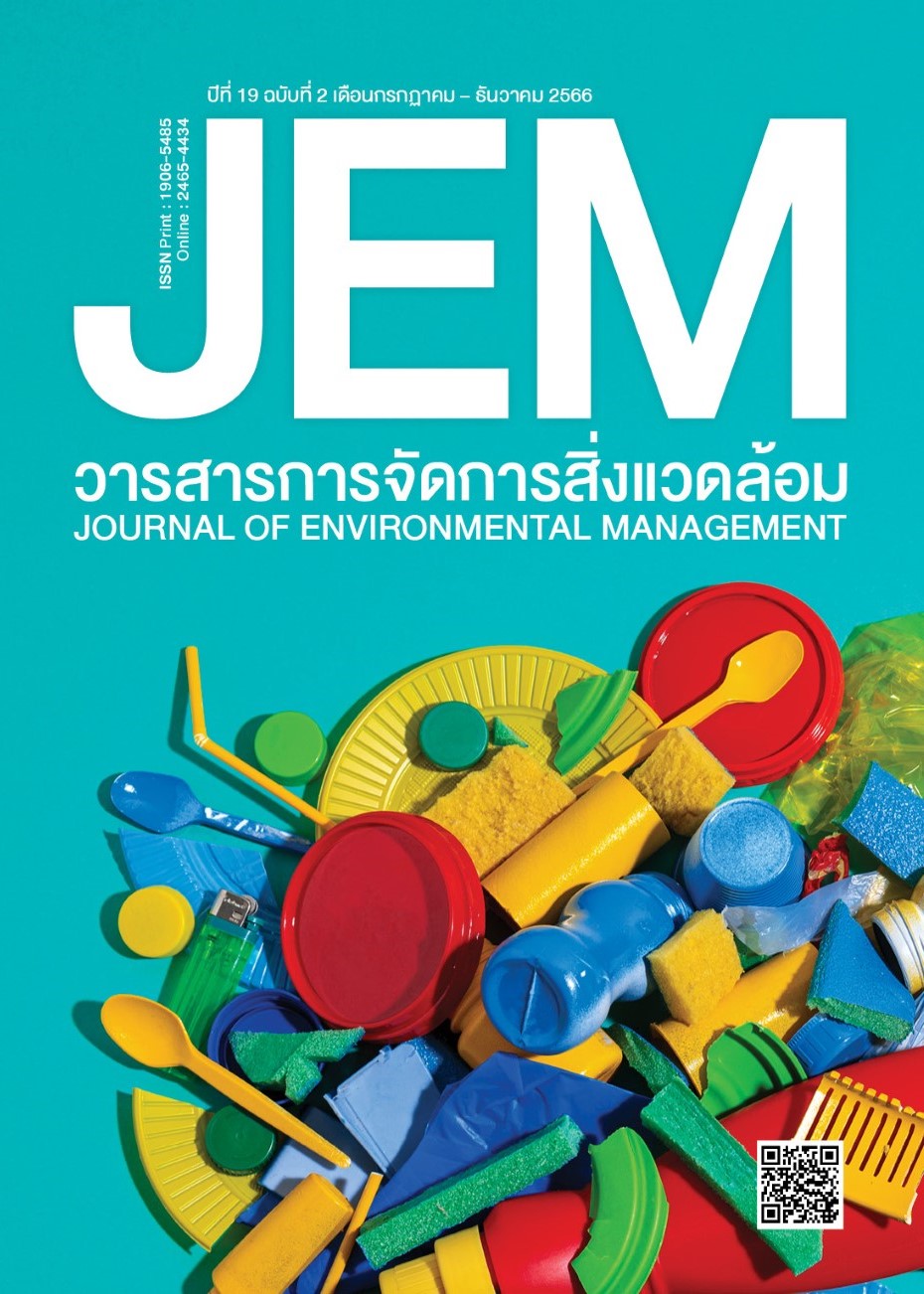การประเมินขีดความสามารถในการรองรับด้านกายภาพของเส้นทางเดินศึกษาธรรมชาติ อุทยานแห่งชาติเขาใหญ่
DOI:
https://doi.org/10.14456/jem.2023.12คำสำคัญ:
ขีดความสามารถรองรับด้านกายภาพ, ขีดความสามารถรองรับด้านกายภาพจริง , เส้นทางเดินศึกษาธรรมชาติบทคัดย่อ
การศึกษานี้มีวัตถุประสงค์เพื่อประเมินขีดความสามารถในการรองรับด้านกายภาพ (Physical Carrying Capacity) เส้นทางเดินศึกษาธรรมชาติในอุทยานแห่งชาติเขาใหญ่ จำนวน 8 เส้นทาง โดยการคำนวณหาจำนวนผู้มาเยือนสูงสุดที่เส้นทางเดินศึกษาธรรมชาติสามารถรองรับได้ มีหน่วยเป็นคนต่อวัน ผลการศึกษาพบว่า เส้นทางเดินศึกษาธรรมชาติน้ำตกกองแก้วมีขีดความสามารถในการรองรับด้านกายภาพมากที่สุด คือ 840 คนต่อวัน และเส้นทางเดินศึกษาธรรมชาติน้ำตกโกรกอีดก มีขีดความสามารถในการรองรับด้านกายภาพน้อยที่สุด คือ 45 คนต่อวัน และจำนวนผู้มาเยือนสูงสุดรวมทั้ง 8 เส้นทาง เท่ากับ 1,845 คนต่อวัน เมื่อทำการประเมินขีดความสามารถในการรองรับด้านกายภาพจริง (Real Physical Carrying Capacity) ของเส้นทางเดินศึกษาธรรมชาติ โดยใช้ตัวประกอบการปรับแก้ 3 ตัวประกอบ ได้แก่ ฝน สัตว์ป่า และการเข้าถึงเป็นตัวคูณลด พบว่าจำนวนผู้มาเยือนสูงสุดลดลงในทุกเส้นทาง โดยมีจำนวนผู้มาเยือนสูงสุดรวมทั้ง 8 เส้นทาง เท่ากับ 1,296 คนต่อวัน ผลการศึกษาเป็นข้อมูลสำคัญสำหรับเจ้าหน้าที่อุทยานแห่งชาติเขาใหญ่เพื่อนำไปใช้ในการกำหนดจำนวนผู้มาเยือนสูงสุดที่เส้นทางเดินศึกษาธรรมชาติแต่ละเส้นทางสามารถรองรับได้เพื่อวัตถุประสงค์ในการป้องกันและลดผลกระทบจากกิจกรรมการท่องเที่ยวต่อสภาพแวดล้อมทางธรรมชาติของพื้นที่ และนักท่องเที่ยวได้รับประสบการณ์นันทนาการที่มีคุณภาพ
เอกสารอ้างอิง
Chongwilaikasem, K. (2023). Khao Yai National Park Development Model Eco-Tourism Management[in Thai]. SSRU Journal of Public Administration, 6(2), 388-403.
Cole, D. N. & McCool, S. F. (1997). Limits of Acceptable Change and Natural Resources Planning: When is LAC Useful, When is it Not?. Retrieve June 10, 2023, from https://www.researchgate.net/publication/238770727_Limits_of_Acceptable_Change_and_Natural_Resources_Planning_When_is_LAC_Useful_When_is_it_Not.
Emphadhu, D. (2019). Unit 5 Resource Management for Tourism in Forest Area [in Thai]. In Resource Management for Forestry and Environment Subject. School of Agriculture and Cooperative. Sukhothai Thammathirat Open University. Sukhothai Thammathirat Open University Publishing Company Limited, Nonthaburi.
Emphadhu, D., Pongsakornrungsilp, P. & Arunpraparat, W. (2019). Determination of tourism carrying capacity of enhancing tourism destinations management standard at Mu Koh Lanta, Krabi Province [in Thai]. Final report, National Research Council of Thailand, Thailand Science Research and Innovation.
Emphadhu, D., Tantasirin, C. & Ratchano, R. (2008). Monitoring of Recreation Carrying Capacity in National Parks. National Park Manual no.10 [in Thai]. Department of National Park, Wildlife and Plant Conservation. Bangkok.
Hector C. L. (1996). Tourism, ecotourism, and protected areas. IUCN Publications Service Unit.
Gland, Switzerland.
Klabsuk, R. & Kwawjumpa, N. (2022). Determination of Recreation Carrying Capacity and Visitor Management at Dong Phrayayen-Khao Yai World Heritage Site final report [in Thai]. Final report, Department of Conservation, Kasetsart University, Bangkok.
Manning, R. (2001). Visitor experience and resource protection: A framework for managing the carrying capacity of national parks. Journal of Park and Recreation Administration, 19(1), 93-108.
National Park Office. (2023). The statistic of visitor in National Park Year 2022. Department of National Park, Wildlife and Plant Conservation, Bangkok. Retrieve October 30, 2023, from https://catalog.dnp.go.th/dataset/stat-tourism.
Premsmith, S. & Dankittikul, C. (2022). The Assessment of Satisfaction with the Use of Tourist Service Areas and Nature Trails: A Case Study of Khao Yai National Park [in Thai]. Buil Environment Inquiry Journal (BEI), 21(2), 91-108.
Queiroz, R. E., Ventura, M. A., Guerreiro, J. A. & Cunha, R. T. da. (2014). Carrying Capacity of hiking trail in Natura 2000 sites: a case study from North Atlantic Island (Azores, Portugal). Journal of Integrated Coastal Zone Management, 14(2), 233-242.
Salemi, M., Jozi, S. A., Malmasi, S. & Rezaian, S. (2019). A New Model of Ecological Carrying Capacity for Developing Ecotourism in the Protected Area of the North Karkhen, Iran. Journal of the Indian Society of Remote Sensing, 47(11), 1937-1947.
Stankey, G. H., Cole, D. N., Lucas, R. C., Peterson, M. E., & Frisell, S. S. (1985). The Limits of Accepatble Change (LAC) System for Wilderness Planning. Retrieve May 5, 2023, from https://www.researchgate.net/publication/247924474_The_Limits_of_Acceptable_Change_LAC_System_for_Wilderness_Planning.
Suksusiang, S., Pongpattananurak, N. & Foster, P. W. (2012). Potential Assessment of Hiking Trails in National Parks, Chiang Mai Province [ in Thai]. Thai Journal of Forestry, 31(2), 108-118.
Thai Meteorological Department. (2021). Precipitation monthly Report year 2011-2021 [in Thai]. Retrieve January12, 2021, from https://tmd.go.th/service/downloadableDocuments.
Tuntates, U., Kwaipan, W. & Silprasit, K. (2016). Inventory of Tourism Resource to Define Nature Learning Routes on Phu Pha Man National Park, Khonkhen and Loei Province [in Thai]. Journal of Humanities and Social Sciences, 8(16).
Valliere, W. & Manning, R.. (2003). Applying the visitor experience and resource protection (VERP) framework to cultural resources in the national parks. Retrieve June10, 2023, from https://www.researchgate.net/publication/237221117_Applying_the_visitor_experience_and_resource_protection_VERP_framework_to_cultural_resources_in_the_national_parks.
Wildlife Research Group. (2014). Wild Elephant knowledge and Guiding Handbook [in Thai]. Wildlife conservation office, Department of National Park, Wildlife and Plant Conservation, Bangkok. Retrieve January12, 2021, from https://www.dnp.go.th/wildlife/technique_document/elephant%20manual/elephant_manual.pdf.



